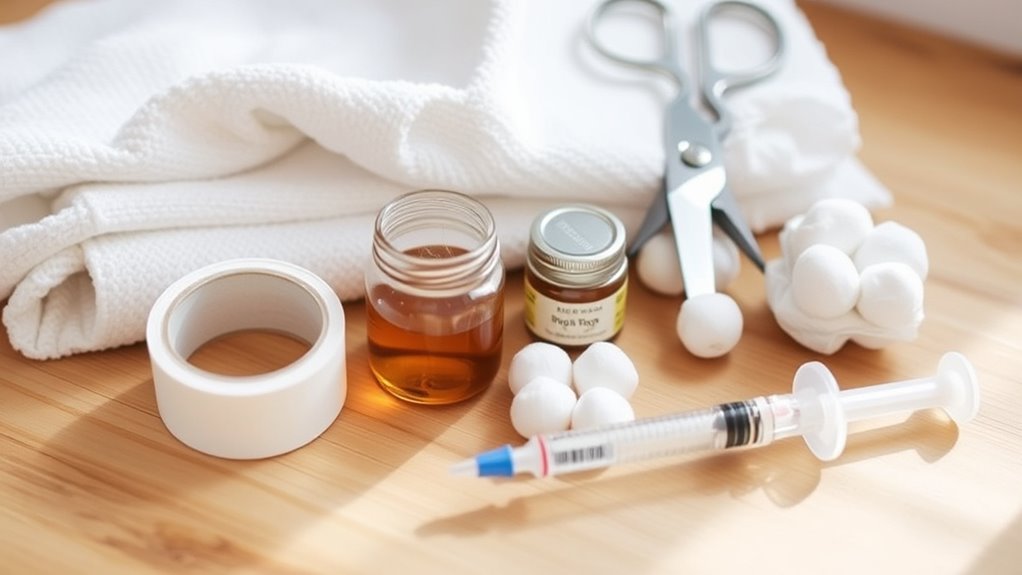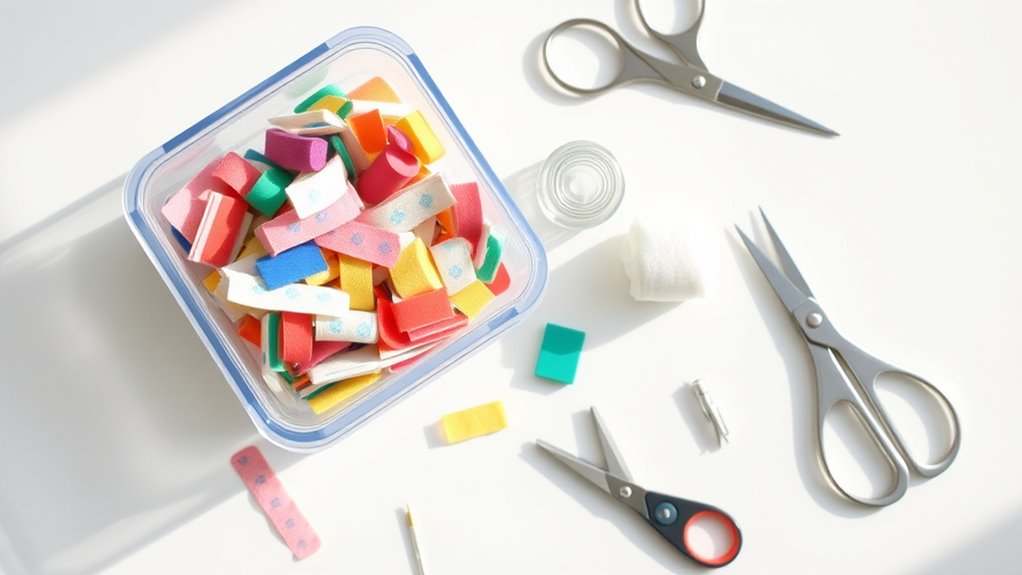To improve your basic first aid on a budget, start by building a kit with household items like bandages, antiseptic wipes, and scissors, keeping costs low. Use free online tutorials to learn essential skills like CPR and wound care, boosting your confidence. Maintain your supplies regularly, replacing expired items and shopping during sales. With these simple steps, you’ll stay prepared without overspending, and if you continue exploring, you’ll discover even more cost-effective tips and tricks.
Key Takeaways
- Use free online tutorials to learn proper first aid techniques and build confidence without additional costs.
- Regularly inspect and update your first aid kit, replacing expired or worn items affordably from dollar stores or bulk buys.
- Incorporate common household items like scissors, tweezers, and gloves to enhance your kit’s effectiveness at low cost.
- Organize supplies in a portable container for quick access during emergencies, ensuring readiness at all times.
- Practice basic skills regularly using free resources to reinforce knowledge and improve response efficiency.
Building a Cost-Effective First Aid Kit With Household Items

Creating a budget-friendly first aid kit is easier than you might think, especially when you use common household items. Start by gathering essentials like adhesive bandages, antiseptic wipes, and gauze from your medicine cabinet. These affordable emergency supplies serve as the foundation of your kit. To make it more effective, incorporate items like scissors, tweezers, and disposable gloves, which you may already have at home. DIY first aid training can help you understand how to use these supplies properly, ensuring you’re prepared for minor injuries. Keep everything organized in a small, portable container. By repurposing items you already own, you save money while preparing a reliable, accessible first aid kit for emergencies.
Mastering Basic Skills Using Free Online Resources and Tutorials

Learning basic first aid skills is more accessible than ever thanks to free online resources and tutorials. You can easily find videos and step-by-step guides that teach CPR techniques, helping you respond confidently in emergencies. These tutorials often include demonstrations on performing rescue breaths and chest compressions correctly. Additionally, you’ll discover effective wound management strategies, such as cleaning cuts, applying bandages, and controlling bleeding. Many reputable sites offer interactive content, quizzes, and practice scenarios to reinforce your skills without any cost. By dedicating a little time to these free resources, you can build a solid foundation in essential first aid procedures. This approach guarantees you’re prepared to handle common injuries, all while saving money and gaining confidence.
Tips for Maintaining and Updating Your First Aid Supplies on a Budget

To keep your first aid kit effective without breaking the bank, regular maintenance and mindful updates are essential. Check your supplies monthly, discarding expired items and replacing them with inexpensive replacements from dollar stores or bulk buys. Be aware of common first aid myths that may lead you to overlook essential items, like believing you don’t need a thermometer or antiseptic. Staying informed helps improve your emergency preparedness without overspending. Keep a list of needed supplies and watch for sales or discounts to stock up on essentials. Reusable items, like scissors or tweezers, save money over time. By staying proactive, you ensure your first aid kit remains reliable, ready to use, and budget-friendly, giving you peace of mind in everyday emergencies.
Frequently Asked Questions
How Often Should I Review and Practice My Basic First Aid Skills?
You should review and practice your basic first aid skills at least once every six to twelve months. Regular first aid refreshers help improve skill retention and make certain you’re prepared in emergencies. By consistently practicing, you build confidence and stay current with the latest techniques. Set reminders for yourself and use affordable resources like online tutorials or practice kits. Staying proactive ensures you’re ready to respond effectively when it matters most.
Are There Any Free Community Courses for First Aid Training?
Are you wondering if there are free community courses for first aid training? Absolutely! Many community programs and local health organizations offer free workshops to help you learn essential skills without spending a dime. These sessions often cover CPR, wound care, and emergency response. Check your local community center, public health department, or online community boards to find upcoming free first aid training events near you.
What Are Common Household Items That Can Be Used as First Aid Substitutes?
You can use common household items as DIY remedies and household alternatives in first aid. For cuts, clean with honey or toothpaste with antiseptic properties. For burns, cool with ice cubes wrapped in a cloth. Use aloe vera gel or yogurt for soothing skin. Toothpaste can help reduce swelling, and a cold spoon works for insect bites. These simple substitutes help manage minor injuries when proper supplies aren’t available.
How Do I Recognize When to Seek Professional Medical Help?
You should seek professional medical help when symptom recognition indicates a serious issue, like heavy bleeding, chest pain, difficulty breathing, or severe burns. Don’t assume minor symptoms will improve—trust your instincts. Conduct an emergency assessment: if symptoms worsen or don’t improve after first aid, it’s time to obtain expert care. Prompt action can prevent complications, so when in doubt, always consult a healthcare professional to ensure safety.
Can I Develop a Comprehensive First Aid Plan on a Limited Budget?
Yes, you can develop a thorough first aid plan on a limited budget by leveraging low-cost training options and DIY first aid methods. Look for free or affordable online courses to build your skills, and assemble a basic first aid kit using inexpensive supplies from local stores. Practice essential skills regularly, and stay informed with trusted resources. This approach guarantees you’re prepared without overspending, enhancing safety for you and your loved ones.
Conclusion
By following these budget-friendly tips, you’ll turn your simple first aid kit into a lifesaving fortress—more powerful than a superhero’s utility belt! With just household items and free online tutorials, you’ll be ready to tackle any emergency faster than a speeding bullet. Keep your supplies updated and your skills sharp, and you’ll be the ultimate first responder in any crisis—no expensive gear needed. Your safety superpowers are just a few smart choices away!









